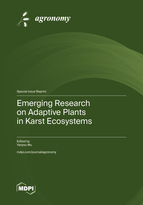Emerging Research on Adaptive Plants in Karst Ecosystems
A special issue of Agronomy (ISSN 2073-4395). This special issue belongs to the section "Farming Sustainability".
Deadline for manuscript submissions: closed (31 March 2023) | Viewed by 26491
Special Issue Editor
Interests: stress physiology; photosynthesis; water metabolism; electrophysiology
Special Issues, Collections and Topics in MDPI journals
Special Issue Information
Dear Colleagues,
Currently, 10 % of the Earth's area can be described as karst landform, and 13% of China's land area is karst. Karst soils, with the characteristics of drought, high pH and high bicarbonate, etc., strongly affect the growth and development of crops. Accordingly, improving crop productivity in karst areas is of vital importance for maintaining ecosystems (carbon neutral), ensuring food supply and promoting sustainable social development.
This Special Issue aims to present studies on the following topics: the adaptive mechanisms of karst-adaptable crops (physiological, genetic, ecological and geochemical mechanisms, etc.); screening principles and technologies of karst-adaptable crop varieties; the allocation and regionalization of karst-adaptable crops in karst areas; and interactions between karst-adaptable crops and biotic or abiotic environments. Cutting-edge research on the following topics is especially welcome: interactions between karst-adaptable and biotic or abiotic environments; utilization strategies for inorganic carbon, nitrogen and nutrition of karst-adaptable crops; and rapid screening technologies for karst-adaptable crops based on plant electrophysiology.
Scientists from all over the world are invited to submit both original research and review articles on these topics.
Prof. Dr. Yanyou Wu
Guest Editor
Manuscript Submission Information
Manuscripts should be submitted online at www.mdpi.com by registering and logging in to this website. Once you are registered, click here to go to the submission form. Manuscripts can be submitted until the deadline. All submissions that pass pre-check are peer-reviewed. Accepted papers will be published continuously in the journal (as soon as accepted) and will be listed together on the special issue website. Research articles, review articles as well as short communications are invited. For planned papers, a title and short abstract (about 100 words) can be sent to the Editorial Office for announcement on this website.
Submitted manuscripts should not have been published previously, nor be under consideration for publication elsewhere (except conference proceedings papers). All manuscripts are thoroughly refereed through a single-blind peer-review process. A guide for authors and other relevant information for submission of manuscripts is available on the Instructions for Authors page. Agronomy is an international peer-reviewed open access monthly journal published by MDPI.
Please visit the Instructions for Authors page before submitting a manuscript. The Article Processing Charge (APC) for publication in this open access journal is 2600 CHF (Swiss Francs). Submitted papers should be well formatted and use good English. Authors may use MDPI's English editing service prior to publication or during author revisions.
Keywords
- adaptive mechanisms
- breeding
- agroecosystems
- resource utilization
- water management
- allocation and regionalization
- plant electrophysiology
- bicarbonate
- karst drought






